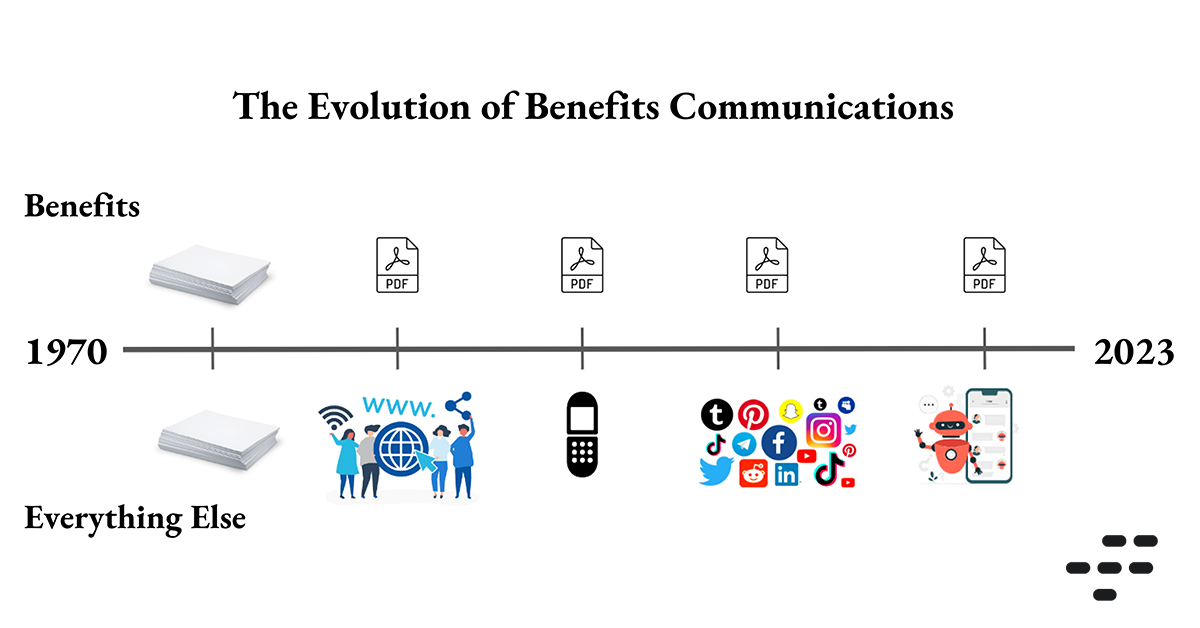
Most employees find benefits confusing. In fact, 1/3 of Americans don’t understand the benefits they picked during open enrollment. Further, it is incredibly challenging to keep employees’ attention long enough for them to understand their benefits. If employees do not engage with their benefits materials within 15 seconds, they will move on to another task. The result is that employees are often over- or under-insured relative to their health needs, driving up costs for themselves and for the plan, and decreasing employee satisfaction and engagement.
Although effective benefits communication is challenging, employees do have the desire to learn and understand. More than half of employees wish their employer would help them understand the benefits that they have elected. Traditional benefits communications - PDF benefit guides, mailers, and email campaigns - just haven’t been able to provide the depth of education that employees need to clearly understand the value of their benefits.
Benefits communications can and should evolve to better support employees, and drive more informed benefits decision-making. Modern tools like benefits apps and microsites streamline benefits communications by offering a centralized location for health plan explanations, enrollment procedures, wellness initiatives, retirement plans, instructional videos, paperwork, forms, and more. At the same time, they allow for interactive education with rich assets and comprehensive decisioning support so employees can choose the right plan for their needs and know how to best utilize it throughout the plan year.
So, why should you consider a tool like a microsite versus a PDF benefits guide? Let’s take a look at the benefits:
With an intuitive benefits microsite that is personalized to an employer’s unique benefits program, brand, and company culture, employers can:
Unlike a PDF, benefits microsites are a living resource that can be accessed on demand and updated on an ongoing basis based on the feedback and questions that are coming from employees. By evolving benefits communications to suit modern employees’ needs, we can drive better health and financial outcomes for employees and employers.

Most employees find benefits confusing. In fact, 1/3 of Americans don’t understand the benefits they picked during open enrollment. Further, it is incredibly challenging to keep employees’ attention long enough for them to understand their benefits. If employees do not engage with their benefits materials within 15 seconds, they will move on to another task. The result is that employees are often over- or under-insured relative to their health needs, driving up costs for themselves and for the plan, and decreasing employee satisfaction and engagement.
Although effective benefits communication is challenging, employees do have the desire to learn and understand. More than half of employees wish their employer would help them understand the benefits that they have elected. Traditional benefits communications - PDF benefit guides, mailers, and email campaigns - just haven’t been able to provide the depth of education that employees need to clearly understand the value of their benefits.
Benefits communications can and should evolve to better support employees, and drive more informed benefits decision-making. Modern tools like benefits apps and microsites streamline benefits communications by offering a centralized location for health plan explanations, enrollment procedures, wellness initiatives, retirement plans, instructional videos, paperwork, forms, and more. At the same time, they allow for interactive education with rich assets and comprehensive decisioning support so employees can choose the right plan for their needs and know how to best utilize it throughout the plan year.
So, why should you consider a tool like a microsite versus a PDF benefits guide? Let’s take a look at the benefits:
With an intuitive benefits microsite that is personalized to an employer’s unique benefits program, brand, and company culture, employers can:
Unlike a PDF, benefits microsites are a living resource that can be accessed on demand and updated on an ongoing basis based on the feedback and questions that are coming from employees. By evolving benefits communications to suit modern employees’ needs, we can drive better health and financial outcomes for employees and employers.

Most employees find benefits confusing. In fact, 1/3 of Americans don’t understand the benefits they picked during open enrollment. Further, it is incredibly challenging to keep employees’ attention long enough for them to understand their benefits. If employees do not engage with their benefits materials within 15 seconds, they will move on to another task. The result is that employees are often over- or under-insured relative to their health needs, driving up costs for themselves and for the plan, and decreasing employee satisfaction and engagement.
Although effective benefits communication is challenging, employees do have the desire to learn and understand. More than half of employees wish their employer would help them understand the benefits that they have elected. Traditional benefits communications - PDF benefit guides, mailers, and email campaigns - just haven’t been able to provide the depth of education that employees need to clearly understand the value of their benefits.
Benefits communications can and should evolve to better support employees, and drive more informed benefits decision-making. Modern tools like benefits apps and microsites streamline benefits communications by offering a centralized location for health plan explanations, enrollment procedures, wellness initiatives, retirement plans, instructional videos, paperwork, forms, and more. At the same time, they allow for interactive education with rich assets and comprehensive decisioning support so employees can choose the right plan for their needs and know how to best utilize it throughout the plan year.
So, why should you consider a tool like a microsite versus a PDF benefits guide? Let’s take a look at the benefits:
With an intuitive benefits microsite that is personalized to an employer’s unique benefits program, brand, and company culture, employers can:
Unlike a PDF, benefits microsites are a living resource that can be accessed on demand and updated on an ongoing basis based on the feedback and questions that are coming from employees. By evolving benefits communications to suit modern employees’ needs, we can drive better health and financial outcomes for employees and employers.